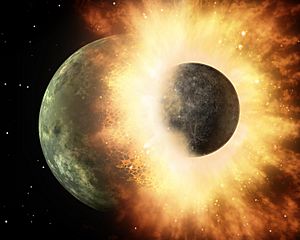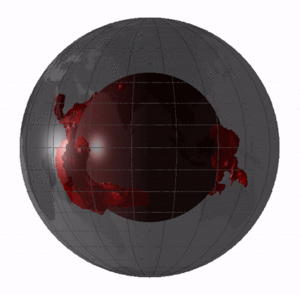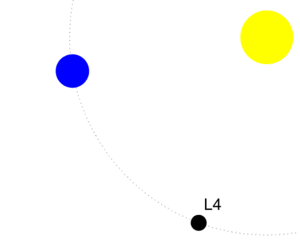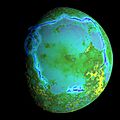Giant-impact hypothesis facts for kids
The giant-impact hypothesis, also known as the Theia Impact, is the leading idea about how our Moon was formed. It suggests that long, long ago, a planet-sized object crashed into the early Earth. The debris from this massive collision then came together to form the Moon.
This idea was first suggested in 1946 by a geologist named Reginald Daly. The planet that crashed into Earth is sometimes called Theia, named after a Greek Titan who was the mother of Selene, the goddess of the Moon.
Scientists believe this huge crash happened about 4.5 billion years ago. That's only about 20 to 100 million years after our Solar System first formed!
In 2016, studies of lunar rocks (rocks from the Moon) suggested that the impact might have been a direct hit. This would have caused both Earth and Theia to break apart and mix together completely.
Contents
Why Scientists Believe This Idea
The giant-impact hypothesis is currently the most popular idea among astronomers for how the Moon formed. Here's why:
- The Moon's path around Earth and Earth's spin are very similar. They are also at a similar angle to the Solar System's flat plane.
- Rocks from the Moon and Earth have almost identical amounts of certain elements. This suggests they came from the same original material.
- The Earth-Moon system has a lot of "spin" or angular momentum. A giant crash could have given it this extra spin.
- Moon rocks show that the Moon was once completely melted. A huge impact would have created enough energy to melt it.
- The Moon has a very small iron core, making it less dense than Earth. Computer models show that if a Mars-sized object hit Earth, its iron core would likely sink into Earth's core. This would leave the Moon to form from lighter, outer parts of both planets.
- The Moon has fewer "volatile" elements (elements that easily turn into gas) than Earth. A high-energy event like a giant impact could have caused these elements to escape into space. The Moon's weaker gravity couldn't hold onto them.
- Scientists have seen signs of similar collisions in other star systems, where they create rings of debris.
- Giant collisions fit well with how scientists think the Solar System formed and changed over time.
However, scientists are still working on some details. For example, a giant impact should have made Earth completely molten, like a "magma ocean." While there's evidence for this, scientists are still trying to create a perfect computer model that shows how the debris from the impact turned into a single Moon.
How the Idea Developed
Early Ideas About the Moon
In 1898, George Darwin (son of Charles Darwin) suggested that Earth and the Moon were once one body. He thought the Moon spun off from Earth due to strong spinning forces. This was the main idea for a while. Darwin calculated that the Moon used to be much closer to Earth and has been slowly moving away. This "drifting away" was later proven by American and Soviet experiments using special mirrors left on the Moon.
However, Darwin's math couldn't fully explain how the Moon could have spun off Earth's surface.
The Impact Idea Emerges
In 1946, Reginald Aldworth Daly from Harvard University suggested that an impact, not spinning forces, created the Moon. But his idea didn't get much attention at first.
Then, in 1974, at a conference about satellites, the idea was brought up again. William K. Hartmann and Donald R. Davis published their ideas in a science journal called Icarus in 1975. Their models suggested that many planet-sized objects existed when planets were forming. One of these could have hit Earth, sending out dust that formed the Moon.
Around the same time, astronomers Alastair G. W. Cameron and William R. Ward also suggested that a Mars-sized object hit Earth at an angle. They thought most of the outer rocky parts of the object would turn into vapor, while its metal core would sink into Earth. This would explain why the Moon has less iron than Earth.
The Kona Conference
Before a big conference in Hawaii in 1984, scientists were challenged to come up with their best ideas about the Moon's birth. At this conference, the giant-impact hypothesis became the most favored idea. Many scientists who were unsure before became convinced that this was the most likely way the Moon formed.
Theia: The Impacting Planet
The name of the planet that supposedly hit Earth is Theia. It comes from the Greek Titan Theia, who was the mother of the Moon goddess Selene. This name was first suggested in 2000 by a scientist named Alex N. Halliday.
Scientists believe Theia was one of many Mars-sized objects that existed in the early Solar System. Theia might have formed in a special, stable spot in Earth's orbit, either ahead or behind it, like a trojan asteroid.
One cool thing about the giant-impact idea is that it fits with how Earth itself formed. Earth likely had many collisions with planet-sized objects during its early days. The Moon-forming collision would have been just one of these "giant impacts," but probably the last really big one.
How the Crash Happened
The Basic Idea
Astronomers think the crash between Earth and Theia happened about 4.4 to 4.45 billion years ago. This was about 100 million years after the Solar System started to form.
Theia likely hit Earth at an angle when Earth was almost fully formed. Computer models suggest Theia hit at about a 45-degree angle. Theia's iron core would have sunk into Earth's core. Most of Theia's outer rocky layer (mantle) would have joined Earth's mantle.
However, a lot of material from both Theia and Earth's outer layers would have been blasted into orbit around Earth. This orbiting material then came together to form the Moon.
Forming the Moon from Debris
Models suggest the Moon formed in stages from this orbiting debris. First, material outside a certain distance (called the Roche limit) started to clump together. This helped to keep the inner disk of material from spreading out too much. Over hundreds of years, this inner disk slowly spread out and formed new objects that added to the growing Moon.
Scientists estimate that about 20% of Theia's original mass ended up as a ring of debris around Earth. About half of this debris then came together to form the Moon. This collision would have also made Earth spin much faster, with a day lasting only about five hours.
A Second Moon?
Some scientists have even suggested that a second, smaller moon, about 1,000 km (620 miles) wide, might have formed in a stable spot near the main Moon. This smaller moon might have stayed in orbit for tens of millions of years. As both moons slowly moved away from Earth, the Sun's gravity might have made the smaller moon's orbit unstable. This could have led to a slow collision where the smaller moon "pancaked" onto what is now the Moon's far side. This would have added material to the far side, making its crust thicker.
This idea could explain why the Moon's far side has fewer dark, flat areas (called maria) than the near side. The thick crust on the far side might have made it harder for molten rock to break through. However, recent mapping by the GRAIL mission has made this "second moon" idea less likely.
New Ideas on Formation
More recent computer simulations (from 2022) suggest that a giant impact could have immediately placed a Moon-like satellite into orbit far from Earth. These models show that even if a satellite initially passed very close to Earth, it could still survive and settle into a stable orbit. These directly formed satellites would also have outer layers made of about 60% material from the early Earth. This helps explain why the Moon's composition is so similar to Earth's.
What the Moon is Made Of
Similarities to Earth
In 2001, scientists found that rocks from the Moon (collected during the Apollo program) had a unique chemical "fingerprint" that was identical to rocks from Earth. This was different from almost all other objects in the Solar System.
In 2014, another team found a tiny, but real, difference in the chemical fingerprint. One idea is that Theia formed very close to Earth, so it was already quite similar in composition.
The fact that the Moon and Earth are so similar in composition is a strong piece of evidence for the giant-impact hypothesis. It's very unlikely that two separate planets would have such similar makeup before a collision.
How They Became Similar
Scientists have come up with different ideas to explain this similarity:
- Mixing Hypothesis: After the giant impact, Earth and the disk of material that would become the Moon were very hot and melted. They might have been connected by a shared atmosphere of hot vapor. This could have allowed the materials to mix and become very similar. For this to work, the Moon-forming disk would need to stay hot for about 100 years.
- Direct Collision Hypothesis: Instead of just a glancing blow, Theia might have hit Earth directly and at a very high speed. This could have completely destroyed Theia, mixing its material thoroughly with Earth's. This idea means Theia's original makeup doesn't have to be as similar to Earth's.
- Synestia Hypothesis: This idea suggests that before the impact, the early Earth was spinning incredibly fast. The impact made it spin even faster, turning it into a temporary, doughnut-shaped object called a "synestia." This unstable synestia existed for about a century before it cooled down and formed both Earth and the Moon.
- Magma Ocean Hypothesis: Another idea (from 2019) suggests that shortly after Earth formed, it was covered by a deep "magma ocean" (a sea of molten rock). Theia, the impacting object, was likely solid. When Theia hit, it heated the magma much more than its own solid parts. This would have caused more material from the early Earth to be blasted out, meaning about 80% of the Moon's material came from Earth, not Theia. Many older models suggested the opposite.
More Evidence
Besides the chemical similarities, other clues support the giant impact:
- The Moon's crust is very rich in a rock called anorthosite, and it has special "KREEP" samples. This suggests a large part of the Moon was once molten, and a giant impact could easily provide that much heat.
- The Moon's small iron core is also explained. The impactor's core would have joined Earth's core, leaving the Moon to form mostly from the lighter, outer layers of both bodies. Earth is the densest planet in our Solar System, and absorbing Theia's core helps explain this.
- Comparing the amounts of zinc in Moon rocks, Earth rocks, and Mars rocks also supports the idea. Zinc easily turns into gas when heated. Moon rocks have less zinc and more heavy types of zinc, which fits with zinc evaporating during a high-energy impact.
- Scientists have seen signs of similar collisions around other young stars. For example, the Spitzer Space Telescope detected warm, dusty debris around stars like HD 172555 and HD 23514. This debris looks like what would be left after planet-sized objects crash into each other.
- In 2023, scientists reported that computer simulations suggest pieces of Theia might still be visible deep inside Earth. They could be the two giant, unusual areas found in Earth's mantle.
Challenges and Questions
Even though the giant-impact hypothesis is the leading idea, there are still some questions:
- The idea suggests Earth would have had a global magma ocean after the impact. While there's evidence for this, scientists are still working on models that perfectly show this.
- The amounts of certain elements (like water) found in Moon rocks are still a bit hard to explain if the Moon formed from a very hot impact.
- The Moon's iron oxide (FeO) content is in between that of Mars and Earth's mantle. This makes it tricky to say exactly how much of the Moon came from Earth's mantle.
- If most of the Moon came from the impactor, the Moon should have more "siderophilic" elements (elements that like iron), but it actually has fewer.
- The Moon's oxygen and titanium isotope ratios are almost identical to Earth's. If Theia was a separate planet, it should have had a different signature, making this similarity hard to explain unless there was extreme mixing.
Why Doesn't Venus Have a Moon?
If giant impacts are common, why doesn't Venus have a moon? One idea is that a second collision might have happened on Venus, canceling out the spin from the first impact. Another idea is that the Sun's strong gravity might have pulled any moons around Venus away or caused them to crash into the planet.
Computer simulations suggest that moons formed by impacts are more likely to survive around planets that are farther from their star and whose moons orbit in line with the planet's spin.
Where Did Theia Come From?
In 2004, scientists suggested that Theia might have formed in a stable spot in Earth's orbit, either 60 degrees ahead or behind Earth. As Theia grew, its gravity might have become too strong for this stable spot, causing it to drift and eventually collide with Earth.
Some evidence suggests the collision might have happened a bit later than first thought, around 4.48 billion years ago. A 2014 study suggested it happened about 95 million years after the Solar System formed.
In 2019, a team found that the chemical makeup of molybdenum in Earth's early mantle came from the outer Solar System. This hints that Theia might have originated from the outer Solar System, possibly bringing water to Earth.
Other Ideas for the Moon's Origin
While the giant-impact hypothesis is the most accepted, other ideas have been suggested:
- The Moon spun off from Earth's molten surface due to spinning forces.
- The Moon formed somewhere else and was later captured by Earth's gravity.
- Earth and the Moon formed at the same time and place from the same disk of material.
None of these other ideas can fully explain why the Earth-Moon system has so much "spin" (angular momentum).
Another idea suggests a large asteroid hit Earth much later than Theia, creating the Moon mostly from Earth's debris. This impact would have created a magma ocean on Earth and a "proto-Moon," with both sharing a hot, vaporized atmosphere. This shared atmosphere would allow their materials to mix and become similar.
A different idea (from 2012) suggests that the Moon and Earth formed together from a massive collision of two planetary bodies, each larger than Mars. These two bodies then crashed into each other again to form what is now Earth. After this second crash, Earth was surrounded by a disk of material that then formed the Moon.
Images for kids
-
Ancient rift valleys – rectangular structure (visible – topography – GRAIL gravity gradients) (October 1, 2014)
-
Ancient rift valleys – context
-
Ancient rift valleys – closeup (artist's concept)
See also
 In Spanish: Teoría del gran impacto para niños
In Spanish: Teoría del gran impacto para niños
- Geology of the Moon
- History of Earth
- Origin of the Moon
- Roche limit






